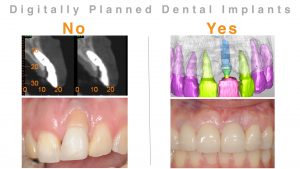 Many dentists around the country seldom or never recommend CBCT (cone beam CT scan) before dental implant treatments. There is a continuing debate between the believers and the skeptics about the efficacy and benefits of CBCT for such treatments. While there is extensive evidence supporting the benefits of Cone Beam CT Scan in diagnosis and planning, there are still many dentists who insist on using only 2-dimensional dental X-rays (panorex or peri-apical X-rays) for their diagnostic imaging for dental implant placement. Their rationale for this decision ranges from concerns about radiation and cost to simply over self-confidence in their success using old techniques. Here is one clinician’s opinion posted in a recent forum discussion:
Many dentists around the country seldom or never recommend CBCT (cone beam CT scan) before dental implant treatments. There is a continuing debate between the believers and the skeptics about the efficacy and benefits of CBCT for such treatments. While there is extensive evidence supporting the benefits of Cone Beam CT Scan in diagnosis and planning, there are still many dentists who insist on using only 2-dimensional dental X-rays (panorex or peri-apical X-rays) for their diagnostic imaging for dental implant placement. Their rationale for this decision ranges from concerns about radiation and cost to simply over self-confidence in their success using old techniques. Here is one clinician’s opinion posted in a recent forum discussion:
“I have a cone beam in my office. I use it a few times a year. I do not need it for implants. The panorex gives me 2D, and my exam completes the 3D. Using the real M-D of a molar 11 mm, and comparing it to the panorex measurements, you can do basic math to measure vertical from the panorex in other areas. Your fingers will tell you of width of the ridge, undercuts in the implant area. I also will take a PA of my pilot a few mm short of any area (nerve or sinus) I am concerned about. Great way to check angulation also…. I’m sorry I do not feel CTs are necessary. And expense and radiation can be avoided. I truly do have a 99% success rate these last 20 years, but admittedly conservative with avoiding immediate implants if possible, and adequate time for bone graft and implant healing.”
In response to opinions such as these, I would like to raise the following points/questions:
- We are 3-dimensional and have 3-dimensional anatomy. Why wouldn’t we diagnose and plan in 3-D?
- The decision to recommend CBCT is best made based on evidence-based dentistry and not on “what I do or what works for me.” This applies when choosing any technique, tools, or materials! If dentists look at evidence-based dentistry and the extensive amount of literature on CBCT, they will never again do any implant treatments using a panorex and palpation (which has been proven to lead to poor decisions and outcomes).
- Every clinician recognized as an expert in implant dentistry who lectures and publishes on the topic uses CBCT and digital planning for treatment planning and execution. Such experts are among the many internationally known and respected leaders in our field. If the experts with remarkable skills recommend CBCT and 3-dimensional diagnosis for implant therapy, what does that say to you?
- Our patients come to us for solutions and put their trust, time, and money in our hands. Don’t we owe it to them to do EVERYTHING we can to deliver predictable treatments and desired outcomes? Why take a chance? Why increase the risk of mishaps? Why lose their trust when things go wrong? For the $295 cost of a Cone Beam CT Scan and a one-time exposure to slightly more radiation, isn’t it worth it to deliver the best and most predictable treatments we can? The exposure to radiation never stops a neurosurgeon, a general surgeon, an orthopedic surgeon, etc. from getting 3-D diagnostics (CT Scan) on their patients. They would not dare make decisions, let alone perform critical surgeries, without seeing and knowing with absolute certainty what is happening.
It is well-recognized that 90% of dental implant complications are due to poor planning and lack of proper diagnostics (and the rest result from inexperience and poor execution). Such complications are completely preventable through comprehensive diagnostics and planning.
If any dentist has doubts about the necessity of 3-D diagnostics and planning for dental implant therapy, I invite them to attend the next dentalXP symposium, Academy of Osseointegration meeting, AAOMS implant meetings, and/or any other periodontal and prosthodontic conferences and see why it is so vital to the field of implant dentistry. I also suggest an article by Dr. Gordon Christensen, as one of the most respected clinicians in the world: http://www.dentaleconomics.com/articles/print/volume-102/issue-8/practice/do-you-need-cone-beam-radiography.html
It is agreed among all experts that 2-dimensional X-rays like panorex or peri-apical X-rays are simply inadequate for diagnosis and planning. Poor planning is the leading cause of most complications in implant dentistry. We owe it to our patients to do everything in our power to prevent complications, and CBCT scans are an invaluable tool in accomplishing this goal.
Watch the video on current digital workflow for achieving optimal precision, predictability, and safety in implant dentistry:
Digital Implant Dentistry for Precise Implant Replacement of Lower Molar Teeth from H. Ryan Kazemi, DMD on Vimeo.